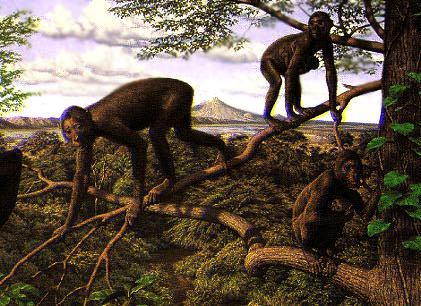The visual predation theory provides a possible explanation for the origins of primates. This theory suggests that primates evolved from small mammals, who lived in bushes found on the forest floor. These small mammals ate insects that also lived on the forest floor. In order to catch an insect, these small mammals may have used their hands. Therefore, their hands would have to be designed for grasping objects. They would also have to have had the ability to see the insect sitting on a plant, rock or on the ground. A hand with separate fingers and an oppposable thumb would be very helpful to catching insects. Claws would not be necessary, in fact claws could have made it harder to catch and hold an insect. Good vision, especially depth perception would be necessary for the survival of an animal who ate insects. Once these features had developed, it would have been easy for the small mammals to leave the forest floor and move into higher branches. The features developed for insect catching , were preadaptions for climbing on thin branches in the trees. The hand, that was so good at catching insects, would also be good for climbing and holding onto small branches. The depth perception needed to catch the insects would have improved the ability of these animials to jump
 between
branches and climb. These features developed for insect catching allowed
early primates to move into the forest canopy and occupy a new niche. Being
able to move on small branches would have allowed these animals access
to foods that other tree climbing animals may not have been able to reach.
The thin branches found on the outside of trees, usually contain a large
amount of fruit, but animals that can only walk on top of the branches,
such an squirrels, cannot move out onto these branches. If they do, the
branch bends under their weight and there is a good possiblity the animal
will fall to the ground. Through time, these early primates may have started
eating different types of food, living in different parts of the forest,
and developing different social systems. The present variations observed
among primates today may have started as a result of this adaptive radiation.
between
branches and climb. These features developed for insect catching allowed
early primates to move into the forest canopy and occupy a new niche. Being
able to move on small branches would have allowed these animals access
to foods that other tree climbing animals may not have been able to reach.
The thin branches found on the outside of trees, usually contain a large
amount of fruit, but animals that can only walk on top of the branches,
such an squirrels, cannot move out onto these branches. If they do, the
branch bends under their weight and there is a good possiblity the animal
will fall to the ground. Through time, these early primates may have started
eating different types of food, living in different parts of the forest,
and developing different social systems. The present variations observed
among primates today may have started as a result of this adaptive radiation.
 chimp-like
pongid that existed around 16 to 18 million years ago (see picture left).
This fossil has been touted as a potential common ancestor for both chimpanzees
and man. During the middle Miocene, around 14 million years ago, there
was a global climatic shift. World climates became drier and warmer at
this time. There are a number of pongid fossils that emerged at this time.
One of the best representatives of this group is Sivapithecus (see picture
above). This fossil shows marked similarity to the present-day Orangutan.
Based on a reconstruction of pongids such as Sivapithecus, it appears that
they were all still quadrupedal around 9 million years ago. The Hominids,
those primates that walk on two legs habitually appear in the fossil record
around 4 million years ago. At present, anthropologists tend to believe
that Hominids diverged from a pongid ancestral form between 5 and 7 million
years ago. Unfortunately, there are few fossils from this period that are
known. Many paleoanthropologists believe that climatic changes around 5.0
million years ago had dramatic affects on fossil ape populations. As forest
areas shrank as a result of drier climatic conditions, competition with
more numerous monkey species may have led to efforts to adapt to ground
environments and ultimately to savannas where bipedality (upright posture)
may have had some advantages.
chimp-like
pongid that existed around 16 to 18 million years ago (see picture left).
This fossil has been touted as a potential common ancestor for both chimpanzees
and man. During the middle Miocene, around 14 million years ago, there
was a global climatic shift. World climates became drier and warmer at
this time. There are a number of pongid fossils that emerged at this time.
One of the best representatives of this group is Sivapithecus (see picture
above). This fossil shows marked similarity to the present-day Orangutan.
Based on a reconstruction of pongids such as Sivapithecus, it appears that
they were all still quadrupedal around 9 million years ago. The Hominids,
those primates that walk on two legs habitually appear in the fossil record
around 4 million years ago. At present, anthropologists tend to believe
that Hominids diverged from a pongid ancestral form between 5 and 7 million
years ago. Unfortunately, there are few fossils from this period that are
known. Many paleoanthropologists believe that climatic changes around 5.0
million years ago had dramatic affects on fossil ape populations. As forest
areas shrank as a result of drier climatic conditions, competition with
more numerous monkey species may have led to efforts to adapt to ground
environments and ultimately to savannas where bipedality (upright posture)
may have had some advantages.